Street naming and numbering procedure
The street numbering function is carried out by the GIS (Geographic Information Services) Team. The following procedure has been devised in collaboration with the Building Control Section and the Committee Clerks section to clarify street numbering and ensure that consistency is attained when dealing with either infill, new developments or renumbering schemes.
The prime purpose of this function of Local Authorities is to facilitate easy identification of premises by, amongst others, the emergency services.
GeoPlace has released the Street Naming and Numbering Code of Practice, which contains guidance for officers. This will form the basis of our procedure and will be followed where possible.
1. New naming and numbering requests
In the case of Major developments, once the developer has commenced building on site a plan will be passed to the Street Numbering Officer, either by an internal department, such as Building Control or Legal Section, or direct from the developer.
For a minor development, single plot or an infill plot the request can come from the Building Control Inspector or direct from the developer, and their recommendations or details of the site location will be passed to the duty Street Numbering Officer.
The developer’s plan must include:
- Total Number of Plots
- Proposed Street Name(s)
- Types of Property: flats including number of storeys and flats per storey
- Door access to street
- Site Boundary
- Access Road and Name
- North Arrow
- Plot Numbers
The Street Numbering Officer will then review the plan and if necessary carry out a site visit to assess the development. If required contact the Developer to resolve any issues.
2. Payments
The Street Numbering Officer will calculate the charge, where applicable, for each request and obtain agreement in writing (by email) from the developer/requestor.
Payments can be made easily online via our website e-store. Other payment options are available such as over the telephone using a debit or credit card, or direct payments can also be made via BACS.
If required, an invoice can be raised against the relevant cost code and sent by post or email for payment. Once payment is received the request can be progressed.
3. Assigning street names
Requests for new street names are carried out in consultation with the, emergency services, Royal Mail and Local Councillors. Local Councillors are engaged early in the process in conjunction with the developer. Once agreed, site notices are put on site for 4 weeks before confirming. This process takes 3 months but notification is not released until payment has been received. The Council, as the Street Naming and Numbering Authority, has the final say on the names proposed.
- Street names are not necessarily required where there is sufficient numbering available along an existing road.
- Street names are not necessarily required where the new properties exist on a private driveway or access and the road does not have curbs and separate road markings.
- Street names are not necessarily required for developments of less than 10 properties.
- Street names are not necessarily required where the roadway is not intended for adoption by Nottinghamshire County Council.
Each case will be reviewed individually, and a decision made on whether a street name is required.
4. Assigning addresses (no charge applied)
The Street Numbering Officer will then prepare a site plan using the developer’s plan. Make a copy of the Developer plan to create draft numbering scheme.
Mark out on draft plan the proposed naming and numbering scheme.
Highlight each different road in a different colour and number all properties on that road in the same colour. To avoid doubt and to ensure consistency the good practice conventions listed in (5) will be used.
5. Good practice conventions
Street naming
Assignment of new addresses will follow the guidance in GeoPlace Street Naming and Numbering Code of Practice where possible. The following local conventions are also applied for new street naming in Ashfield.
Name prefixes
- New street names should not duplicate any similar name already in use in the district or neighbouring districts. A variation in the terminal word, i.e. ‘street, ‘road’, ‘avenue’, etc, will not be accepted as sufficient reason to duplicate a name.
- Street names should not be difficult to pronounce or awkward to spell. In general, words of more than three syllables should be avoided.
- Avoid aesthetically unsuitable names such as Gaswork Road, Tip House, Coalpit Lane, or names capable of deliberate misinterpretation like Hoare Road, Typple Avenue, Swag House, Quare Street etc.
- Avoid having 2 phonetically similar names within a postal area and, if possible, within a town i.e. Kirkby/Sutton or Hucknall, e.g. Alfred Road and Alfred Close, or Churchill Road and Birch Hill Road.
- Names of living people will not be considered at all, and names of the deceased will only be considered 50 years after their death. An exception may be made if the person has made some contribution of national or local significance, i.e. died in military service, significant community involvement.
- The consent of the Lord Chamberlain's office must be obtained if a name with any reference to the Royal family or the use of the word ‘Royal' is suggested. For further information, visit:
- website: Use of Royal Arms, Names and Images - Royal.UK (external link)
- email - RoyalNames@cabinetoffice.gov.uk (current as of February 2024)
- The use of North, East. South or West (as in Alfred Road North and Alfred Road South) (or East, West) is only acceptable where the road is continuous and passes over a major junction. It is not acceptable when the road is in two separate parts with no vehicular access between the two. In such a case one half should be completely renamed.
- Where possible names should reflect the history of the site or acknowledge the geography of the area.
- Names that could be seen as advertising are not acceptable.
- Names beginning with ‘THE’ will be avoided where possible.
Name suffixes
- Subsidiary names (e.g. a row of buildings within an already named road being called ‘Example Terrace’) should not be used if possible. However, in some situations this may be preferable depending on the existing numbering.
- Some suggestions for traditional street name suffixes are listed. Others may be used if suitable:
- Street - for any road
- Road / Way - for major roads
- Road / Avenue / Drive - for residential roads
- Grove / Lane / Gardens(subject to there being no confusion with any local open space)
- Place / Crescent - for a crescent shaped road
- Close - for a cul de sac only
- Square - for a square only
- Hill - for a hillside road only
- Circus - for a large roundabout
- Terrace - for a terrace of houses(provided it is not a subsidiary name)
- Vale / Mead / Rise - for residential roads only for exceptional use if pushed
xiii. New pedestrian ways should end with one of the following suffixes (others may be used):-
- Walk
- Path
- Way
xiv. New block names should end with the one of the following suffixes:
- House / Court - residential only
- Point - high block residential only
xv. Tower high block offices or residential for private houses it is sufficient that the name should not repeat the name of any house or building in the area.
Street numbering
- All numbering will start at the beginning of a road (usually the end closest to the town centre).
- Numbers will be assigned with odds of the left of the street and evens on the right of the street when standing at the beginning of the street with your back to the town centre.
- Only use natural numbers (natural numbers are positive whole numbers from 1, examples are 1,2,3,4,5), do not use fractions.
- All numbers will be used including number 13.
If the developers plan does not offer a similar number of properties on both sides of the street consider the following alternatives.
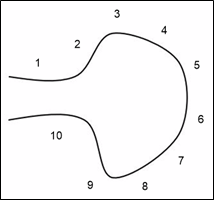
If in the case of a small Cul-de-Sac consider consecutive numbering with number one issued to the first house on the left
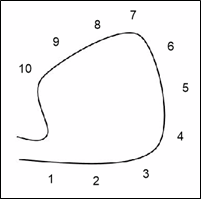
If in the case of a small Cul-de-Sac if first property on the right hand dominates the street entrance, number from there
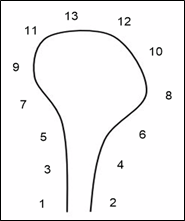
In a large Cul-de-Sac the split between odd and even is at the head of the Cul-de-Sac
If a Cul-de-Sac development is restricted to only one side of the road. Number consecutively.
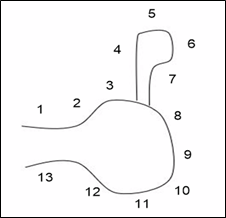
In the case of offset properties normally at 90° to the main street, number properties outward from road.
-
For infill numbering, all available numbers will be used first with letters being applied if necessary. Avoid using letters beyond ‘C’

A single plot of infill follows the existing numbering scheme but with the ‘a’ suffix attached to the lowest adjacent number within the existing scheme.
If multiple infill plots, follow existing numbering scheme but with the a, b, c suffix attached to the lowest adjacent number within the existing scheme.
If 2 properties are merged into one, the numbering scheme will be in consultation with the owner/developer. The preferred option is the lowest of the old numbers.
-
Existing numbering
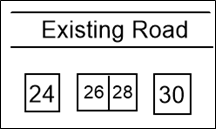
-
Merged properties
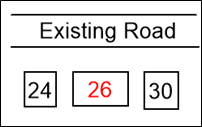
If in rural location, consider existing numbers of adjacent streets.
If dealing with a development that falls between a large number sequence gap. Do not use lowest number. Try to retain suitable numbers either side for future use.

- Flats are numbered from the ground floor upwards using number and letter.
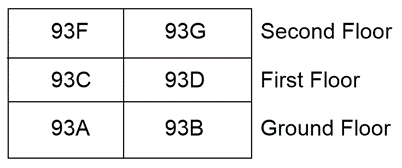
Where there are more than two flats on a floor, these are numbered clockwise. Number properties against the street that the front door entrances onto. Avoid the use of ‘FLAT’ where possible.
- These features should not be included in the numbering scheme.
- Garages
- Car Ports
- Underpasses
- Car Parks spaces
- Sub Station
- Existing properties shown on plan
- Commercial Units
Should the Street Numbering Officer require further clarification the matter shall be referred to their immediate line manager for resolution.
6. House names
- Naming of properties will follow the guidelines set out for naming of street name prefixes (see section 5 i–x)
- Names which duplicate, in full or in part, names on nearby properties will not be accepted.
- Names which duplicate in full or in part, the name of a nearby street name will be reviewed.
7. Completion
Once the draft scheme has been completed the Street Numbering Officer will issue an official notification containing a letter and location plan using the following rules.
- Rotate the plan to North prior to annotation
- Use black ink
- Scribe numbers onto plan
- Colour code the number against the street name
- For flats include separate key of positions
Example of a street numbering plan
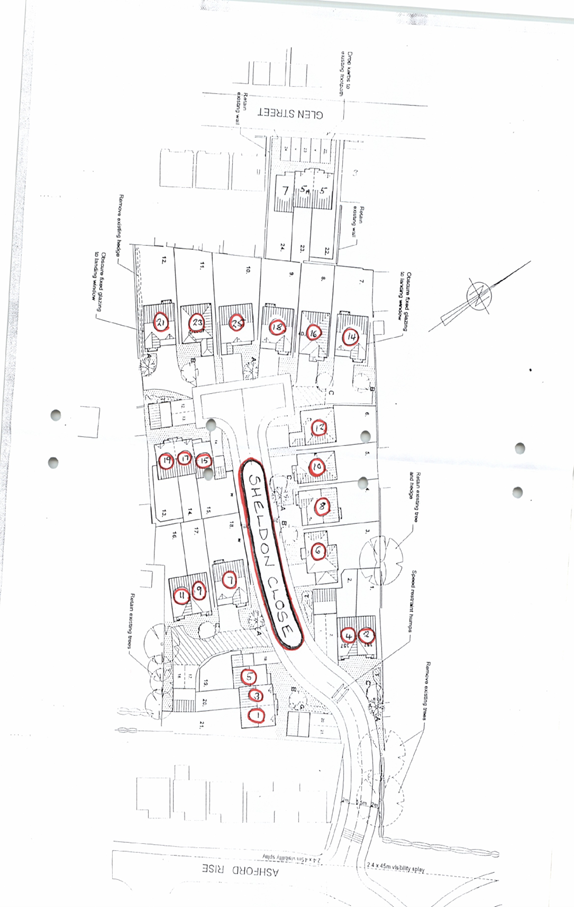
8. Distribution of notification (charge applied)
Once a new street numbering scheme has been confirmed and the relevant fee paid, notification needs to be sent to the authorities and organisations listed below (see Appendix A).
9. Re-naming or re-numbering
There are occasions where existing naming and numbering is found to be unsatisfactory and changes need to be made, Complaints come from many sources and all should be properly investigated before deciding on a course of action.
If it is decided that renaming/numbering is necessary, the essential services should first be proposal and consultation.
It is then necessary to seek observations from all persons who are residents or owners of the properties being renumbered by a renaming and renumbering proposal. This is best achieved by the Public Display of an Official Notice in the area to be affected, and by writing to affected occupiers.
Following the expiry of a reasonable time (suggest 28 days), a decision is reached taking into account objections and other observations received.
A positive response to change is required from two-thirds of land/property owners & tenants to confirm the change unless there are other extenuating circumstances.
A charge is often applicable
- link: Schedule of Charges.
10. Enforcement
On occasion, it is necessary to consider enforcement action to ensure the display of correct names and numbers. Informal action should in all cases be tried first. If however, persuasion fails to achieve results we will consider taking enforcement action.
11. Record keeping
All requests are recorded in Outlook, under a shared inbox. All correspondence and contact concerning the request is also saved. This allows the function to continue during leave or absence.
Once completed a paper copy of the notification letter and plan is printed and filed in the SNAN files along with all associated paperwork.
A pdf copy the notification letter and plan, along with all associated electronic correspondence, is then filed in P drive on the IT network.
Policy contents
- Introduction
- Legislation
- Street naming and numbering policy
- Definition
- Aim and purpose
- Scope
- Service delivery
- Charges
- Monitoring and review
- Sustainability, equality and regeneration
- Contact details
- Street naming and numbering procedure
- New naming and numbering requests
- Payments
- Assigning street names
- Assigning Numbers
- Good practice conventions
- Street naming
- Street numbering
- House naming
- Completion
- Distribution of notification
- Re-Naming or re-numbering
- Enforcement
- Record keeping
- Appendices
- Appendix A – Interested parties for notification
